A bar feeder seems like a relatively simple device. The most common automation accessory in our world of high volume turning, it provides a reliable way of delivering material to the machine tool for extended periods of time, saving an operator from continually loading blanks into a chuck.
In reality, bar feeders have many nuances from one to another to make them more suitable for certain shop environments. Length and capacity are only the beginning. Other factors should be considered during the purchasing process as well.
Length and Capacity
Visually, the most obvious difference in bar feeders is the length. Generally, full-size bar feeders are capable of feeding 12-foot-long bars (some are even longer). Short loaders can handle up to 6 feet, while spindle-length bar feeders are designed for 3- and 4-foot lengths. One consideration in determining which kind to purchase may be floor space limitations, but other factors may be significant enough to sway a shop to find the necessary square footage.
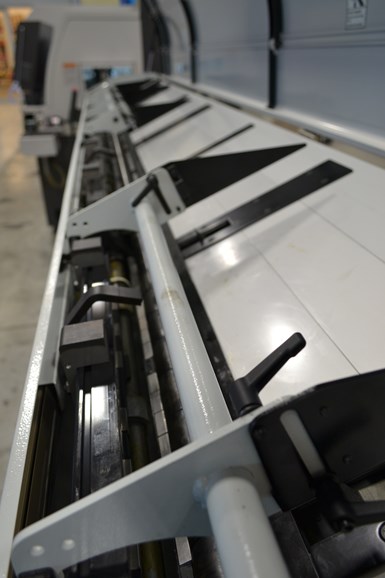
Magazine bar feeders hold multiple bars in reserve to extend the time a machine can run unattended.
Twelve-foot bar feeders are often considered a requirement for sliding headstock Swiss lathes. Spindle-length loaders only load bars as long as the lathe spindle. Clearly, the floor space they take up is a lot less, but the customer must cut the bars into 2-, 3- or 4-foot sections to the length of the lathe spindle.
Another advantage of the 12-foot bar feeder is that it produces fewer (and typically shorter) remnants. With each section of bar loaded, a shop should expect a single remnant, so cutting the 12-foot bar into three or four pieces will result in three or four remnants. Because Swiss machines typically are running short cycle times, the 12-footer makes more sense to extend the production run.
To take full advantage of the 12-foot bar feeder’s capacity to allow long runs (often 8 hours or more), the magazine style, which holds multiple bars in reserve, should be used. Conversely, single-tube bar feeders, which handle 12-foot bars exclusively, take up even more floor space. They are about 20 feet long because they don’t have the dual feeder for the short pusher versus the long pusher.
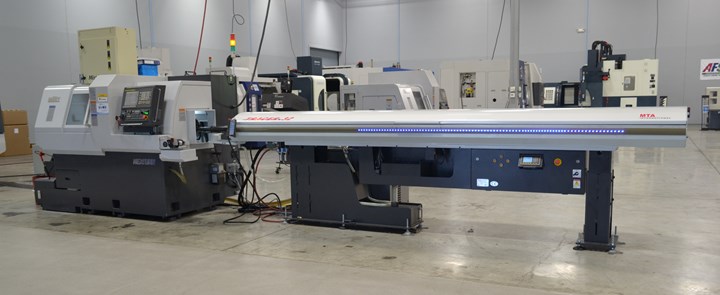
Twelve-foot bar feeders are often considered a requirement for sliding headstock Swiss lathes.
But when bar diameters get up to about 2 inches, 12-foot magazine bar feeders begin to get far more expensive, according to CNC Indexing & Feeding Technologies. The company offers 12-footers up to 2-inch diameter and short loaders with maximum diameters ranging from 2.5 inches to 4 inches.
Straightness is often dependent on the material supplier, but a bar can also be ground for straightness.
While bar straightness is not as critical on short loaders, it’s quite important on the 12 footers. If the bar is not straight, then it will vibrate in the bar feeder, be noisy and will affect the finish on the part. The bars can run with a little bit of bend or runout, but too much will cause severe vibration and will negatively affect the finish of the part. Straightness is often dependent on the material supplier, but a bar can also be ground for straightness. If it is to be run on a Swiss machine, it’s almost always ground for size and straightness to accommodate the guide bushing.
Magazine bar feeders play a significant role in lights-out turning operations. According to the company, one customer who is producing complex washers, targets 10-second cycle times. If the customer was using a single, 12-foot bar, it could only run it for an hour and a half. By being able to put 10 bars in the magazine bar feeder, they can easily run through the night. The aluminum part is forgiving, and diamond or PCB tools provide reliable tool life. Besides having enough material, important factors for lights-out include size and complexity of the part as well as tool life, the company says. The magazine bar feeder will allow the machine to run unattended as long as the process allows it.
Bar diameter directly affects the capacity of the bar feeder. Typical of most bar feed manufacturers, the majority of the 12-foot magazine bar feeders offered by CNC Indexing will hold about 23 bars at 3/8-inch diameter. In Swiss sliding headstock operations, 38 mm is commonly the largest diameter size. In that case, these bar feeders would hold about seven bars.
Another possible consideration for the capacity of a bar feeder is the total weight of the material that is being loaded. The total weight of seven 1.5-inch 4140 stainless bars is considerable. While bar feeders from CNC Indexing do not have weight restrictions, others may. If weight is limited, the number of bars that can be loaded may be limited, which would also affect the length of time the machine can run unattended.
Feeding the Bar
Other available features on bar feeders can affect how accurately the bar is fed through the machine. With a servo-driven bar feeder, the control allows the operator to specify how far the bar should be fed through the spindle, based on what is needed for the next part. A pneumatic system, on the other hand, uses air to drive the pusher and push the bar until it hits a turret stop. Both styles have their advantages, whether cost, accuracy or speed.
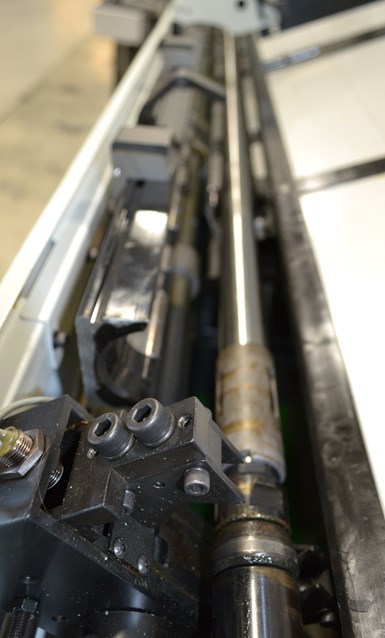
During operation, a pusher retracts all the way to the end of the feeder, a new bar drops into the channel, and the pusher feeds the bar in as it is needed. The channel keeps the bar from vibrating or moving up and down.
Pneumatic bar feeders are generally less expensive, but could result in more remnant or waste. When the bar is fed, the stop may not be positioned precisely, sometimes allowing the bar to be fed as much as a quarter inch further than necessary. This material will be faced off, so that much material will be lost for each time the bar is incremented, in addition to the remnant at the end of the bar. While bars that are fed with a servo-driven feeder, which is more precise, are often faced as well, it’s only a minimal amount. (Servo-driven feeders are more precise and usually don’t need a stop, saving a tool position.) Of course, the type of material being used is significant in determining the cost advantages either way, as any losses in exotic materials such as titanium or Inconel can add up quickly.
Instead, people will buy 12-foot bars and then, based on the length of their headstock, rather than cutting a 12-foot bar in half and having two 6-footers, they might cut it into four 3-foot bars or three 4-foot bars
When people are shopping for a short bar feeder, they sometimes assume they can cut their 12-foot bars in half and run 6-foot bars. But with these short bar feeders, they are limited by the length of the headstock. Whatever the difference is between the length of the headstock and the length of the bar will be the length of the remnant because the bar feeder can’t push past the start of the headstock and does not handle the bar while it is turning in the machine.
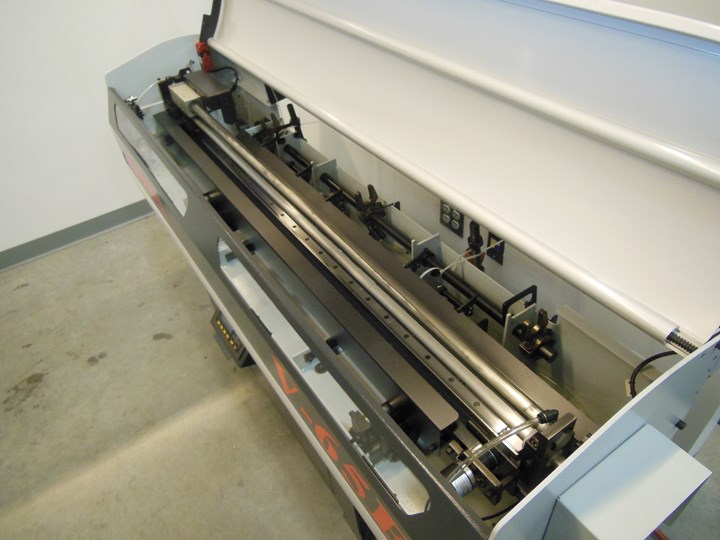
Short bar loaders are capable of loading spindle-length barstock into the lathe spindle Their smaller size is often better for shops with limited floor space.
Instead, people will buy 12-foot bars and then, based on the length of their headstock, rather than cutting a 12-foot bar in half and having two 6-footers, they might cut it into four 3-foot bars or three 4-foot bars, which gives them more remnant pieces, but allows them to use the majority of the 12-foot bar rather than taking it and having one long remnant.
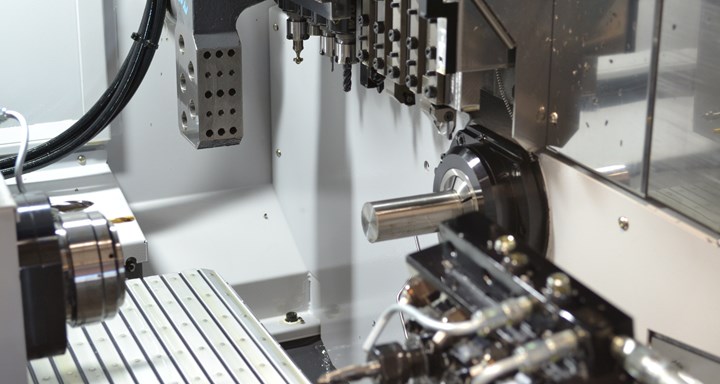
With a servo-driven bar feeder, the control allows the operator to specify how far the bar should be fed through the spindle, based on what is needed for the next part. A pneumatic system, on the other hand, uses air to drive the pusher and push the bar until it hits the turret stop.
In many cases, the remnant isn’t necessarily waste, as it can be used on another machine by putting it into a chuck as a blank to make a part. But in production shops that are running large runs, putting all of those remnant pieces into a chucker is not practical, so they become waste. This situation is typical in the Swiss market, where common remnant lengths are between 2 to 6 inches. These are almost always waste because of the short cycle times.
A Good Fit
Depending on the diameter of the barstock and spindle, spindle liners can be used to compensate for considerable differences. The liners are available in different diameters to fit the different bar sizes. For a long time, spindle liners were made from steel, which would be noisy with out-of-round stock. The vibration would also cause the liners to wear out. In the last 10 years or more, polyurethane liners have become popular, allowing for quieter operation and easier modifications of the liners if needed for other machines.
The liner is installed into the spindle, holding a good fit for the bar to help keep it straight and keeping the centerline of the material fed in on the chuck’s centerline. According to CNC Indexing, if inch and a half bar is being fed through a 3-inch spindle with no liner, gravity would cause the material to drop down to the bottom of the spindle. As it comes through the chuck, the centerline would be off.
A rule of thumb for spindle liner diameter, the company says, is that it should be no more than 100 thousandths larger than the material size. With plus/minus specifications for material, bars can come in larger than the quoted size, so the liner needs to be able to accommodate that difference. While some range is necessary inside the spindle liner, it should fit the material as closely as possible to avoid whip in the material as it is rotating.
Smaller diameters and the lack of bar straightness will cause more tendency for whip and, therefore, increase the importance of a good fit in the spindle liner. If a 3-inch spindle liner is installed and then a shop changes to a 2-inch bar, it is not always necessary to change to a smaller liner, as long as the bar is pretty straight. But the spindle liners should match more to the size of the material as it gets smaller.
Improving Efficiency
Minimizing operator intervention, even to the point of lights-out operations, is the main reason for using bar feeders. But shops should also consider the cost of employment, as personnel and floor space are the largest expenses a shop usually faces. So when considering how much space a bar feeder may occupy, a shop owner should also think about how it may make the production process more efficient.
People often think that to maximize the use of a bar feeder, they need to be running the same part over and over in a production run. CNC Indexing and Feeding Technologies says that’s simply not true. Most shops are running mostly the same types of material and similar part sizes. A shop can run 500 pieces with a bar loader, and while that job is running, the operator can be overseeing two other machines. When the first job is complete, the operator can quickly load the program for another part of similar size and have the machine up and running again. Even if the cycle time is 3 minutes on a conventional lathe, do you really want to pay an operator to stand there and wait, then open the door, pull out the part and put the next blank in for each piece when a bar loader can free him up to be more productive by running other machines at the same time? Even in small lots, shops are always looking to be more efficient, trying to increase throughput with shorter lead times.
Like other forms of automation, bar feeders can make a big difference in a shop’s efficiency and higher production rates. It’s important to weigh the advantages of different models to determine what is the best fit for each situation, but as long as space and cost allow, the bar feeder may provide the right boost to turning operations.
Related Content
Starting Small with Automation
Quick-change workholding and flexible robotic automation started this small shop on the path to success.
Read MoreGerman Project Yields Three New Medical Machining Processes
Recent research has resulted in a new mix of high-speed turn whirl milling, polygon turning and rotational turning for manufacturing medical bone screws and out-of-round nails.
Read MoreParting Off: The Case for Standardizing on Sawing
The value of rotary saw cutting for parting off operations could boil down to simple economics paired with process efficiency gains.
Read More4 Strategies for Managing Chip Control
Having strategies in place for managing chips is an important part of protecting the production process, from tool life to product quality.
Read MoreRead Next
The Biggest Bang for Your Automation Buck
Bar feeders are the primary automation option for the precision turned parts shop. Selecting the best bar feeder for the application is important for maximizing the production benefits of this technology.
Read MoreChoosing an Automatic Bar Feeder
The bar feeder is the most common form of automation for turning operations. Selecting the right one requires consideration of the applications for which it will be used.
Read MoreTechnology Advances Automation Trends
Shops of all sizes looking for better efficiency are realizing the benefits of a deeper investment into automation.
Read More























